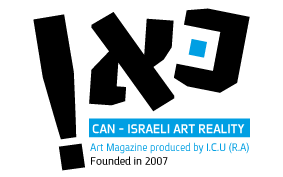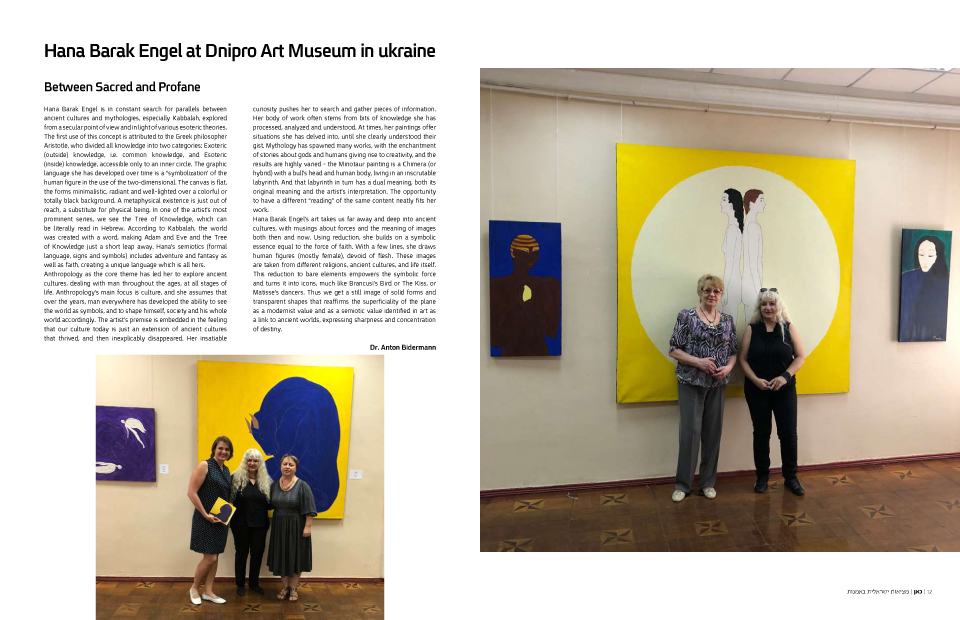
| Home Page | Editor Notices | Museums | Galleries | Publication | Donation | Contact Us |


 | |||||||||||||||
| |||||||||||||||


| |||||||||||||||
| hana barak engel at dnipro art museum in Ukraine |
Hana Barak Engel is in constant search for parallels between ancient cultures and mythologies, especially Kabbalah, explored from a secular point of view and in light of various esoteric theories. The first use of this concept is attributed to the Greek philosopher Aristotle, who divided all knowledge into two categories: Exoteric (outside) knowledge, i.e. common knowledge, and Esoteric (inside) knowledge, accessible only to an inner circle. The graphic language she has developed over time is a “symbolization’ of the human figure in the use of the two-dimensional. The canvas is flat, the forms minimalistic, radiant and well-lighted over a colorful or totally black background. A metaphysical existence is just out of reach, a substitute for physical being. In one of the artist’s most prominent series, we see the Tree of Knowledge, which can be literally read in Hebrew. According to Kabbalah, the world was created with a word, making Adam and Eve and the Tree of Knowledge just a short leap away. Hana’s semiotics (formal language, signs and symbols) includes adventure and fantasy as well as faith, creating a unique language which is all hers. Anthropology as the core theme has led her to explore ancient cultures, dealing with man throughout the ages, at all stages of life. Anthropology’s main focus is culture, and she assumes that over the years, man everywhere has developed the ability to see the world as symbols, and to shape himself, society and his whole world accordingly. The artist’s premise is embedded in the feeling that our culture today is just an extension of ancient cultures that thrived, and then inexplicably disappeared. Her insatiable curiosity pushes her to search and gather pieces of information. Her body of work often stems from bits of knowledge she has processed, analyzed and understood. At times, her paintings offer situations she has delved into, until she clearly understood their gist. Mythology has spawned many works, with the enchantment of stories about gods and humans giving rise to creativity, and the results are highly varied - the Minotaur painting is a Chimera (or hybrid) with a bull’s head and human body, living in an inscrutable labyrinth. And that labyrinth in turn has a dual meaning, both its original meaning and the artist’s interpretation. The opportunity to have a different “reading” of the same content neatly fits her work. Hana Barak Engel’s art takes us far away and deep into ancient cultures, with musings about forces and the meaning of images both then and now. Using reduction, she builds on a symbolic essence equal to the force of faith. With a few lines, she draws human figures (mostly female), devoid of flesh. These images are taken from different religions, ancient cultures, and life itself. This reduction to bare elements empowers the symbolic force and turns it into icons, much like Brancusi’s Bird or The Kiss, or Matisse’s dancers. Thus we get a still image of solid forms and transparent shapes that reaffirms the superficiality of the plane as a modernist value and as a semiotic value identified in art as a link to ancient worlds, expressing sharpness and concentration of destiny. Dr. Anton Bidermann Read more  |
| all rights reserved - CAN ISRAELI ART REALITY |
| סייבורג מחשבים - בניית אתרים |